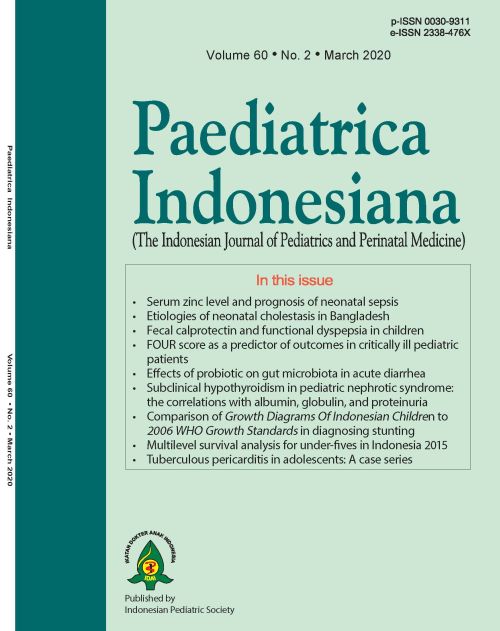Full outline of unresponsiveness score as a predictor of outcomes in critically ill pediatric patients
DOI:
https://doi.org/10.14238/pi60.2.2020.77-82Keywords:
: full outline of unresponsiveness score; critically ill; prognosis outcome; pediatric intensive care unitAbstract
Background Mortality predictions are very important for improving service quality in the pediatric intensive care unit (PICU). The full outline of unresponsiveness (FOUR) is a new coma scale and is considered capable of predicting mortality and outcome.
Objective To assess the ability of FOUR scores to predict outcomes of critically ill patients in the PICU.
Methods This prospective cohort study included children aged 1 months - 18 years who were admitted to the PICU. Subjects were assessed by FOUR, grouped into score < 9 or score >9, and followed until outcomes were obtained. Bivariate analysis to assess the risk of death was made by cross-tabulation and the strength of the association in the form of risk ratio by Chi-square test. Multivariate analysis was done by logistic regression test.
Results Of 94 subjects, 47 had FOUR scores <=9 and 47 subjects had FOUR >9. Bivariate analysis revealed that PICU patients with FOUR score <=9 had a higher risk of death than those with FOUR score >9 (RR 12.5; 95%CI 3.1 to 49.8; P<0.0001). Multivariate analysis revealed that FOUR score, length of stay <=7 days, and non-surgical disease significantly increased the risk of mortality in PICU patients (by 42.8 times, 8.9 times, and 5.9 times, respectively).
Conclusion The FOUR scores have good ability to predict the outcomes of critically ill pediatric patients. A FOUR score <=9 at the beginning of treatment is significantly associated with the outcome of mortality during treatment in the PICU.
References
2. Pollack MM, Ruttimann UE, Wiley JS. Nutritional depletions in critically ill children: associations with physiologic instability and increased quantity of care. J Parenter Enteral Nutr. 1985;9:309-13. DOI: 10.1177/0148607185009003309.
3. Metta D, Soebardja D, Hudaya D. The use of pediatric logistic organ dysfunction (PELOD) scoring system to determine the prognosis of patients in pediatric intensive care units. Paediatr Indo. 2006;46:1-6. DOI: 10.14238/pi46.1.2006.1-6.
4. Pollack MM, Patel KM, Ruttimann UE. PRISM III: An updated pediatric risk of mortality score. Crit Care Med. 1996;24:743-52. DOI: 10.1097/00003246-199605000-00004.
5. Lacroix J, Cotting J, Severity of illness and organ dysfunction scoring in children. Pediatr Crit Care Med. 2005;6:126-34. DOI: 10.1097/01.PCC.0000161287.61028.D4.
6. Shann F, Pearson G, Slater A, Wilkinson K. Pediatric index of mortality (PIM): a mortality prediction model for children in intensive care. Intensive Care Med. 1997;23:201-7. DOI: 10.1007/s001340050317.
7. Wijdicks EFM, Bamlet WR, Maramattom BV, Manno EM, McClelland RL. Validation of a new coma scale: the FOUR score. Ann Neurol. 2005;58:585-93. DOI: 10.1002/ana.20611.
8. Dewi R, Mangunatmadja I, Yuniar I. Perbandingan full outline of unresponsiveness score dengan glasgow coma scale dalam menentukan prognostik pasien sakit kritis. Sari Pediatri. 2011;13:215-20. DOI: 10.14238/sp13.3.2011.215-20.
9. Akavipat P. Endorsement of the FOUR score for consciousness assessment in neurosurgical patients. Neurol Med Chir. 2009;49:565-71. DOI: 10.2176/nmc.49.565.
10. Fischer M, Rüegg S, Czaplinski A, Strohmeier M, Lehmann A, Tschan F, et al. Inter-rater reliability of the full outline of unresponsiveness score and the glasgow coma scale in critically ill patients: a prospective observational study. Crit Care. 2010;14:R64. DOI: 10.1186/cc8963.
11. Dahlan MS. Besar sampel dalam penelitian kedokteran dan kesehatan. 4th ed. Jakarta: Epidemiologi Indonesia; 2016. p. 105-119.
12. Saraswati DD, Pudjiadi AH, Djer MM, Supriyatno B, Syarif DR, Kurniati N. Faktor risiko yang berperan pada mortalitas sepsis. Sari Pediatri. 2014;15:281-8. DOI: 10.14238/sp15.5.2014.281-8.
13. Yuniar, I, Latief A, Devaera Y, Fitriani S. Pemberian nutrisi pada pasien dengan penyakit kritis di ruang perawatan intensif anak RS Cipto Mangunkusumo. Sari Pediatri. 2014;16:254-9. DOI: 10.14238/sp16.4.2014.254-9.
14. Marlina L, Hudaya D, Garna H. Perbandingan Penggunaan Pediatric Index of Mortality 2 (PIM2) dan Skor Pediatric Logistic Organ Dysfunction (PELOD) untuk memprediksi kematian pasien sakit kritis pada anak. Sari Pediatri. 2008;10:262-7. DOI: 10.14238/sp10.4.2008.262-7.
15. Schaible UE, Kaufmann SHE. Malnutrition and infection: complex mechanisms and global impacts. PLoS Med. 2007;4:806-12. DOI: 10.1371/journal.pmed.0040115.
16. Correia MI, Waitzberg L. The impact of malnutrition on morbidity, mortality, length of hospital stay and costs evaluated through a multivariate model analysis. Clin Nutr. 2003;22:235-9. DOI: 10.1016/s0261-5614(02)00215-7.
17. Cheifetz IM. Invasive and noninvasive pediatric mechanical ventilation Respir Care. 2003;48:442-53; discussion 453-8. PMID: 12667269.
18. Principi T, Fraser DD, Morrison GC, Farsi SA, Carrelas JF, Maurice EA, et al. Complications of mechanical ventilation in the pediatric population. Pediatr Pulmonol. 2011;46:452-7. DOI: 10.1002/ppul.21389.
19. Adisasmito AW, Hadinegoro SR. Infeksi Bakteri Gram Negatif di ICU Anak: epidemiologi managemen antibiotik dan pencegahan. Sari Pediatri. 2004;6:32-9. DOI: 10.14238/sp6.1.2004.32-5.
20. Meilyana F, Djais J, Garna H. Status gizi berdasarkan subjective global assessment sebagai faktor yang memengaruhi lama perawatan pasien rawat inap anak. Sari Pediatri. 2010;12:162-7. DOI: 10.14238/sp12.3.2010.162-7.
21. Bordini AL, Luiz TF, Fernandes M, Arruda WO, Teive HAG. Coma scales: a historical review. Arq Neuropsiquiatr. 2010;68:930-7. DOI: 10.1590/S0004-282X2010000600019.
21.22. Iyer VN, Mandrekar JN, Danielson RD, Zubkov AY, Elmer JL, Wijdicks EFM. Validity of the FOUR score coma scale in the medical intensive care unit. Mayo Clin Proc. 2009;84:694-701. DOI: 10.1016/S0025-6196(11)60519-3.
Downloads
Published
How to Cite
Issue
Section
License
Authors who publish with this journal agree to the following terms:
Authors retain copyright and grant the journal right of first publication with the work simultaneously licensed under a Creative Commons Attribution License that allows others to share the work with an acknowledgement of the work's authorship and initial publication in this journal.
Authors are able to enter into separate, additional contractual arrangements for the non-exclusive distribution of the journal's published version of the work (e.g., post it to an institutional repository or publish it in a book), with an acknowledgement of its initial publication in this journal.
Accepted 2020-03-16
Published 2020-03-16


















